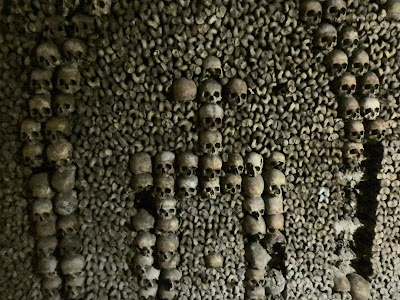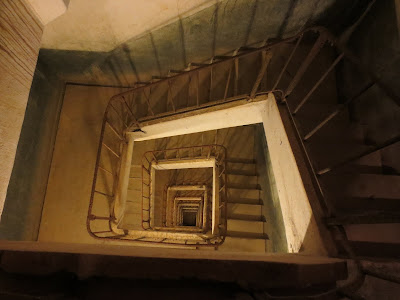I first read about the
the Maginot Line as a young military-minded boy and fell in love with the idea of the extended interlinked mountainous forts separating France from Belgium, Luxembourg, and Germany. The idea of a fortified subterranean wall built into the sides of mountains, with crew quarters, generators, elevators and a train track, was the stuff dreams were made of. I've always wanted to see, so leapt at the chance when Marie asked "What's the one thing you've always wanted to do in France?"
Often held as a prime example of France's supposed military incompetence, we're told the line was conceived as an extension and natural evolution of trench warfare developed during World War 1. With this diminution of France's strategic plan, of course the story goes that Hitler's blitzkrieg simply flew over it, or went around. That's not the story as it apparently happened, though.
Planned in 1927 with full-scale construction beginning in 1929, the line was meant to slow a German attack to allow time for France to marshal her forces for a counter offensive, and to funnel advancing armies away from geographic weak points of France's relatively open borders. The line's intent was never to repel a German attack, and in this, it arguably did its job, to relative degrees given factors beyond the military's control: prevailing politics of the authorizing bodies having elevated bad decision makers to oversight of the line. The "site" we spent the day touring, blowing many of my perceptions of the Line away, was the first point at which the Germans breached the Line and began their advance through France.
We woke early and had a big breakfast, knowing we'd be on our feet for the next 12 hours. Our tour guide
Richard, a friend of our hosts, gathered us and advised the weather was not ideal and ponchos were called for. Not knowing the scope of the tour (wasn't it all tunnels, bunkers, and trenches?), we reluctantly took rain gear from our generous hosts and went on our way. Richard, a Brit expat, was buoyant and excitable, clearly loving his foreign home and the cherishing every bit of history found in every single step he took. After giving an overview of each country's strategic plan and a look at the geography of the land we were about to explore, we set out thinking we would go to a bunker and spend the day walking through.
More accurate than the childhood fort, buried in the French country hills, this is what the Maginot Line looks like:


Far from being disappointing however, the real story belies a great disservice to French military tactics, technology, resolve, and ingenuity. Rather than a continuous wall of fortifications, the Line is made up of a series of fortified sunken structures, with little profile against the terrain and natural foliage camouflage, dependent on interlocking fields of reciprocal fire. Even before getting to these, however, observation posts and hidden pillboxes lined the highways the Germans were most likely to take. These were disguised as country cottages, and were placed as a gauntlet to slow the invading convoy. This one, partially a recreation, told the story of a 5 man team who held the Germans up for 15 minutes, allowing a 16 year old serviceman time to bicycle down and inform command to man the line. The squad leader explained to the boy telephone lines had been severed, knowing full well they had not. Our tour guide had recounted meeting the now 93 year old boy a few years ago, who was only alive because of this lie.
A few kilometers down the road, the Line proper began. The smallest and most numerous are called blockhouses, and are one or two room structures with 2-6 man positions operating machine guns which provided cover for larger gun casemates, operating anti-tank weaponry and larger anti-materiel guns. At times the blockhouses were oriented in line with the enemy, providing defense in the direction of advance. Around the larger (though still small) casemates are where we began to see the image often associated with the Line. There were trenches running out to the closest cover positions, as well as small sleeping areas and storage space for food.
The blockhouses and casemates were fortified well. This casemate's damage was inflicted by 88mm antitank rounds, over the course of several hours.
 |
| We counted 32 points of impact, presumably from the same 88mm artillery. |
The surviving three men in this two room blockhouse were eventually overrun. An SS detachment imbedded with the German infantry lined them up and summarily executed them. Those bullet holes are torso height and fired at point-blank range.
Most known for the giant installations known as
ouvrages, the Maginot Line is much more than a series of concrete pillboxes. The
ouvrages garrisoned anywhere from between 100 and 1,000 troops, all underground, with retractable 135 mm howitzers, providing (again, interlocking field of fire) artillery support. We toured a smaller example of the smallest kind of
ouvrage, named
La Ferté. It consisted of 2 blocks, and at the time that it fell had a crew of 100. Due to the bureaucracy associated with preparing the Maginot Line for attack, and the thought that the Ardennes forest would make a German attack improbable,
La Ferté was ill-equipped with substandard architecture, engineering, machinery, and escape routes. Over the course of four days, the
ouvrage remained unbreached but increasingly combat ineffective, until fuel from the generators caught fire on day three, killing all 100 men via carbon monoxide poisoning. Their bodies were mostly recovered from a transportation tunnel 300 feet underground.
 |
| The entry way |
 |
| What they were defending |
 |
| Artillery rounds striking one of the cloches, a retractable armament dome |
 |
| The winch to raise the largest cloche |
 |
| When all resistance had ended, the Germans used breaching charges to begin securing the structure. |
 |
| Uninhabited bed frames were in the line of overpressure from the charges. |
 |
| 300 foot-long tunnel, 300 feet underground. |
 |
| Infirmary |
 |
| Interesting example of logistical failure: mess for 2000 soldiers, in a structure staffed with 100. |
 |
| Antitank gun |
 |
| Smaller door breach |
It was a long day and we left with sombre moods. Expected was the disjunct between reality and imagination. Admittedly, the ouvrage we toured was minor in the Line overall, and still impressive. The terrible fate and partially told stories of the men that died in La Ferté removed most of my lingering boyhood imaginative joy.























































